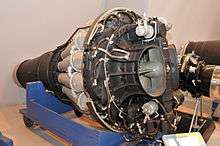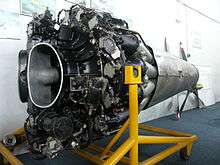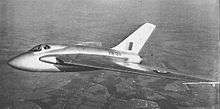de Havilland Goblin
| Goblin | |
|---|---|
 | |
| Cutaway Goblin II | |
| Type | Turbojet |
| Manufacturer | de Havilland Engine Company |
| First run | 13 April 1942 |
| Major applications | de Havilland Vampire Gloster Meteor |
| Developed into | de Havilland Ghost |
The de Havilland Goblin, originally the Halford H-1, is an early turbojet engine designed by Frank Halford. The Goblin built by de Havilland was the second British jet engine to fly (after the Power Jets W.1) and the first to pass type tests and receive a "Gas Turbine" class type rating.[1]
The Goblin was the primary engine of the de Havilland Vampire, and was to have been the engine for the F-80 Shooting Star (as the Allis-Chalmers J36) before that design switched engines due to production delays. The Goblin also powered the Saab 21R, Fiat G.80 and de Havilland Swallow. The Goblin was later expanded into the larger de Havilland Ghost, with the model numbers continuing from the last marks of the Goblin.
Design and development

Design of the engine was carried out by Frank Halford at his London consulting firm starting in April 1941.[2] It was based on the basic design pioneered by Frank Whittle, using a centrifugal compressor providing compressed air to sixteen individual flame cans, from which the exhaust powered a single-stage axial turbine. Compared to Whittle designs, the H-1 was "cleaned up" in that it used a single-sided compressor with the inlet at the front, and a "straight through" layout with the flame cans exhausting straight onto the turbine. Whittle's designs used a "reverse flow" layout that piped the hot air back to the middle of the engine, in order to "fold" it and reduce its length. Halford's changes made his engine somewhat simpler than Whittle's designs, notably allowing one of the main bearings to be removed. Nevertheless it was a fairly compact design, even without the Whittle-style "folding".
The H-1 first ran on 13 April 1942, and quickly matured to produce its full design thrust within two months. It first flew on 5 March 1943 in the Gloster Meteor, and on 26 September in the de Havilland Vampire.[3] It was around this time that de Havilland purchased Halford's company and set him up as the chairman of the de Havilland Engine Company, with the engine name changing from H-1 to "Goblin", while the new H-2 design became the "Ghost" - de Havilland jet and rocket engines were all named after spectral apparitions.
In July 1943, one of the two H-1s then available (actually the spare engine intended as a backup for the one installed in the Vampire prototype) was sent to the United States, where it was selected to become the primary engine of the Lockheed P-80 Shooting Star. This engine was fitted to the prototype which first flew on 9 January 1944. The engine was later accidentally destroyed in ground testing, and was replaced by the only remaining H-1 from the prototype Vampire.[3] Allis-Chalmers was selected to produce the engine in the US as the J36, but ran into lengthy delays. Instead, the Allison J33, developed by a General Electric as the I-40 (their greatly improved 4,000 lbf (18 kN) version of the J31, itself based on Whittle's W.1), was selected for the production P-80A.
Variants

- H.1/Goblin I
- Developed about 2,300 lbf (10.2 kN) thrust (nominal thrust for prototype) and 2,700 lbf (12.0 kN) for production models.
- Goblin II
- 3,100 lbf (13.8 kN)
- Goblin 3
- 3,350 lbf (14.9 kN)
- Goblin 35
- 3,500 lbf (15.6 kN)
- Goblin 4
- 3,750 lbf (16.7 kN)
- Allis-Chalmers J36
- Licence production in the United States by Allis-Chalmers.
Applications
Aircraft applications

- Curtiss XF15C-1
- de Havilland DH 108 Swallow
- de Havilland Vampire
- Fiat G.80
- Gloster Meteor
- Lockheed XP-80 Shooting Star
- Saab 21R
Alternative applications
Engines on display
Goblin engines are preserved and on display at several museums including:
- Brooklands Museum
- Canadian Warplane Heritage Museum
- de Havilland Aircraft Heritage Centre
- Midland Air Museum
- Royal Air Force Museum Cosford
- Shuttleworth Collection
- Vintage Flying Museum
Survivors
As of June 2011, two Goblin powered de Havilland Vampires remain airworthy on the British register.[4]
As of December 2014, two Goblin powered de Havilland Vampires remain airworthy in North America. N115DH is owned by the World Heritage Air Museum.[5] and C-FJRH is operated under the Jet Aircraft Museum in Ontario, Canada.[6]
As of November 2015, three Goblin powered de Havilland Vampires remain airworthy in South Africa. Serial number 276 and 277 are in the SA Air Force Museum and the third is at Wonderboom Airport.
Specifications (D.H Goblin II D.Gn 27)
General characteristics
- Type: Turbojet
- Length: 107 in (2,718 mm)
- Diameter: 50 in (1,270 mm)
- Dry weight: 1,550 lb (703 kg)
Components
- Compressor: Single sided, centrifugal flow
- Combustors: 16 chambers
- Turbine: Single stage axial flow
- Fuel type: Kerosene (R.D.E. / F / KER)
- Oil system: metered pressure spray at 50 psi (344.7 kPa) dry sump, 40 S.U. secs (13 cs) (Intavia 620) grade oil
Performance
- Maximum thrust: 3,000 lbf (13.34 kN) at 10,200 rpm at sea level
- Overall pressure ratio: 3.3:1
- Air mass flow: 60 lb (27.22 kg) /sec at 17,000 rpm
- Turbine inlet temperature: 1,472 °F (800 °C)
- Fuel consumption: 3,720 lb/hr (465 imp.gal/hr), (1,687 kg/h) or (2,114 l/h)
- Specific fuel consumption: 1.18 lb/lbf/hr (120.285 kg/kW/h)
- Thrust-to-weight ratio: 1.9 lbf/lb (0.0186 kN/kg)
See also
- Related development
- Related lists
References
Notes
Bibliography
- Gunston, Bill. World Encyclopedia of Aero Engines. Cambridge, England. Patrick Stephens Limited, 1989. ISBN 1-85260-163-9
- Smith, Geoffrey G.Gas Turbines and Jet Propulsion for Aircraft, London S.E.1, Flight Publishing Co.Ltd., 1946.
- Kay, Anthony L. (2007). Turbojet History and Development 1930-1960 1 (1st ed.). Ramsbury: The Crowood Press. ISBN 978-1-86126-912-6.
- Wilkinson, Paul H. (1946). Aircraft Engines of the world 1946. London: Sir Isaac Pitman & Sons. pp. 286–287.
External links
| Wikimedia Commons has media related to De Havilland Goblin. |
- DH Goblin at EnginesUK
- "De Havilland Goblin" a 1945 Flight article
- "Series II Goblin" a 1946 Flight article
- "Development of the Goblin Engine" a 1947 Flight article
- "Maintenance At A Minimum - D.H. Goblin Completes a Second 500-Hour Test Run" - a 1949 Flight news item
| ||||||||||||||||||||||
| ||||||||||||||
| ||||||||||||||
| ||||||